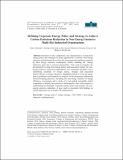Defining corporate energy policy and strategy to achieve carbon emissions reduction in non-energy intensive multi-site industrial organisations

View/
Date
2017-07-05Author
Finnerty, Noel
Contreras, Sergio
Sterling, Raymond
Coakley, Daniel
Keane, Marcus M.
Metadata
Show full item recordUsage
This item's downloads: 711 (view details)
Recommended Citation
Contreras, Sergio, Finnerty, Noel, Sterling, Raymond, Coakley, Daniel, & Keane, Marcus M. (2017). Defining corporate energy policy and strategy to achieve carbon emissions reduction in non-energy intensive multisite industrial organisations. Paper presented at the 10th International Conference on Sustainable Energy and Environmental Protection: Energy Management and Policies, Bled, Slovenia. DOI: 10.18690/978-961-286-051-6
Published Version
Abstract
Research on the components and characteristics of long-term
energy policy and strategies in large organisations is limited. Non-energy
intensive multinationals do not face the environmental regulations required
by their energy intensive counterparts, further widening the “energy
efficiency gap” due to missed opportunities. This work investigates the
development of long-term energy policy and associated strategy for nonenergy
intensive multi-site organisations via a systematic literature review
identifying essentials of energy policy, strategy and associated
barriers/drivers to energy efficiency. Highlights include a review of energy
policy guidelines and standards, an analysis of the parameters influencing
decision-making practices, including the non-energy benefits of energy
efficiency investments and a study of 6 top-ranked sustainable global
companies to identify best-practices. Subsequently, this work proposes a
methodology to formulate ‘corporate energy policy and strategy’ for nonenergy
intensive industries. A case study is presented with findings on
initial deployment in a Fortune 500 multinational.
Collections
Except where otherwise noted, this item's license is described as Attribution-NonCommercial-NoDerivs 3.0 Ireland
Related items
Showing items related by title, author, creator and subject.
-
Super-insulate or use renewable technology? Life cycle cost, energy and global warming potential analysis of nearly zero energy buildings (NZEB) in a temperate oceanic climate
Moran, Paul; Goggins, Jamie; Hajdukiewicz, Magdalena (Elsevier, 2017-01-13)There are numerous strategies available to design and construct a low energy or nearly zero energy building (NZEB). However, the design strategy for a building depends on a high number of factors including location, climate, ... -
Mobilising IS to support the diffusion of energy management practices outside of Ireland¿s LIEN (Large Industry Energy Network)
Costello, Gabriel (Association Information et Management, 2010-05)Ireland is under increasing pressure to reduce energy consumption to meet carbon emission targets and protect an economy that is almost totally dependant on imported energy. The implementation of no cost and low cost ... -
Defining corporate energy policy and strategy to achieve carbon Emissions reduction Targets via energy MANAGEMENT in non-energy intensive multi-site manufacturing organisations
Finnerty, Noel; Sterling, Raymond; Contreras, Sergio; Coakley, Daniel; Keane, Marcus M. (Elsevier, 2018-03-14)Research on the characteristics of long-term energy policy and associated strategies in multisite manufacturing organisations is limited. Non-energy intensive multinationals do not face the environmental regulations ...

